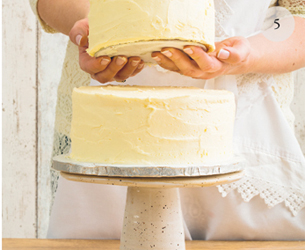Assembling tiers
Dowels
To support the tiers of the cake you will need to use dowels. Dowels are only used to support the layer above them, so naturally the top tier will not need any, unless you are using a heavy cake topper.

- Place the bottom tier of the cake on the covered cake drum. Take a cake board or cake tin the same size as the next tier up, and gently press it into the centre of the bottom tier. Take it off carefully and you should be left with a faint impression of the cake board on the fondant. This will be your guide to placing the dowels so that they are hidden under the layer above and do not show.

- Insert the first dowel into the bottom tier, relatively close to the line—say, about half a centimetre or quarter of an inch—inside the guidelines. Use an edible ink pen (or alternative) to mark the point on the dowel where it emerges from the cake. Take this dowel out, and cut it down to the height you have marked.

- Use the first dowel as a measure to cut the remaining dowels for this tier to the same size. Insert the dowels into the cake making sure that they are spaced evenly just inside the edge of the guideline.
Merging the tiers
- Insert the dowels in the bottom tier. If the cake is covered with buttercream, continue to the next step. If the cake is covered with ganache, first spread a blob of melted ganache on top of the bottom cake before adding the next tier. For fondant-covered cakes, take a small grape-size piece of fondant and quickly run it under water from a tap; then massage the fondant until it becomes sticky. Spread this goo onto the top of the first cake.

- Gently slide your hands under the board of the next tier and carry it over to the bottom tier (obviously, the closer together that you have the cakes at this point, the less chance you have of dropping it). Carefully lower the second tier onto the one below, making sure that it is as central to the bottom tier as possible. Lean the furthest part of the board onto the bottom tier and slide your hands out. The upper tier should only have a small distance to fall until it settles on the bottom tier. Check that the second cake is placed centrally: if it is off-centre then gently (sooo gently) push it from the side using an even pressure until the position is correct. You may need to smooth over the side you pushed if it has any fingerprints, or add a little buttercream or ganache and then smooth it in.
- Repeat the dowelling process in the next tier, then add the third tier in the same manner as described above. If you are merging buttercream and ganache-covered cakes then you may need to add a little more icing between the tiers if there are any gaps.
Number of dowels required for different cake sizes
| 15 cm (6 inch) | 3 dowels |
| 18 cm (7 inch) | 4 dowels |
| 20 cm (8 inch) | 4 dowels |
| 23 cm (9 inch) | 5 dowels |
| 25 cm (10 inch) | 5 dowels |
Merging a tall, thin cake
There are a couple of projects in this book where the tiers are all the same size. Merge the tiers using basically the same method as above, but with a few differences.

- Insert the dowels 2 cm (¾ inch) in from the edge of the bottom cake.

- If the cakes are naked cakes (that is, they have no outer covering) use a board that is 2.5 cm (1 inch) smaller than the cake, so a 20 cm (8 inch) cake would sit on an 18 cm (7 inch) board.
For a cake that is covered with the same buttercream all over, crumb-coat the cakes as described in the method here. Merge the tiers before icing and then coat all the cakes with the thick buttercream covering at the same time.
